One of the most intriguing questions about the Giant Seacow is:
"What did the living creature look like?"
Two sources are available for a reconstruction:
- three amateur-drawings by eye witnesses
- Steller's description of the animal

The three original drawings are from various editions of the Waxell Chart. According to Hintzsche the top one was drawn by Sofron Chitrow (pen and watercolour) after Sven Waxell.

These drawings clearly show the short hooked forelegs, as Steller had described them.
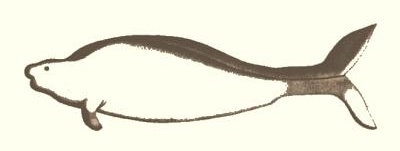 The third rather crude sketch appeared in Eugen Büchner in "Die Abbildungen der nordischen Seekuh" (1891).
The third rather crude sketch appeared in Eugen Büchner in "Die Abbildungen der nordischen Seekuh" (1891).Interesting is the way the edge of the fluke has been drawn.
Further drawings, which Steller, according to Stejneger, caused to be made, presumably by Plenisner, are lost.
2. Steller's Description

In July 1742 Steller measured and dissected a female animal and made meticulous notes. I have worked the mayor sizes and circumferences, with some personal assumptions *, into this contour drawing ...
Click into image for higher resolution

... resulting in this overall contour (from above).
Steller wrote that the animals "walked" around in the shallow water on their "arms", with their backs and half the body always above the surface, like "overturned boats". We can therefore assume a horizontal position and a bent spine.
3. Reconstructions
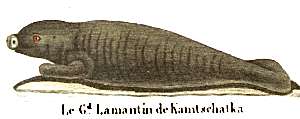
1817 a French artist imagined this seal-like animal.

1846 J.F. Brandt, Director of the St. Petersburg Zoological Museum, published this not too convincing image.

Leonhard Stejneger imagined the scene, in which Steller dissected a Seacow.
(Steller makes first measurements of Sea Cow, in his translation of Steller's Journal of the Sea Voyage from Kamchatka to America, 1925.)
The dimensions largely agree with my hypothetical contour drawing (above).
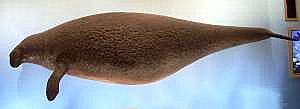 The Braunschweig model shows a rather slim animal, with a clearly defined neck (Steller: "the head like the neck is ill-defined and joins the body in such a way that a line of distinction is nowhere visible.")
The Braunschweig model shows a rather slim animal, with a clearly defined neck (Steller: "the head like the neck is ill-defined and joins the body in such a way that a line of distinction is nowhere visible.")Photo H. Rothauscher
The forelegs are too long and flipper-like ...
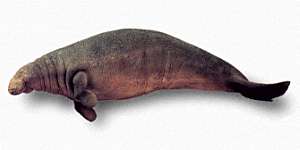 ... the same applies to the Milan Model created by Valter Fogato (shown here in a more horizontal position), the tail muscles are probably to strong and dolphin-like, giving the origin of the fin too large a circumference.
... the same applies to the Milan Model created by Valter Fogato (shown here in a more horizontal position), the tail muscles are probably to strong and dolphin-like, giving the origin of the fin too large a circumference.Otherwise a very convincing and lively reconstruction.
Larger photo on Valter Vogato's Page.
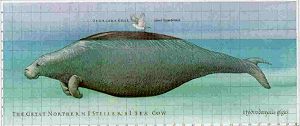
1987 Dugald Stermer drew this seacow under D. Domning's direction. (from D. Domning (1987), Sea Cow Family Reunion)

This reconstruction drawn 1989 by Pieter Folkens (advised by D. Domning), shown here as contour, avoids many of the previous errors. (thumbnail from the Poster for the National Marine Educator's 1989 Conference Miami)
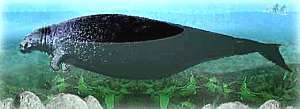
My own drawing 2003.
Steller described the animal as "strange and absurd ...".
We will probably never know how absurd it really was!
I would be grateful for comments and new facts,
and am looking for further unknown illustrations of Steller's Seacow.
Please mail
We will probably never know how absurd it really was!
I would be grateful for comments and new facts,
and am looking for further unknown illustrations of Steller's Seacow.
Please mail
